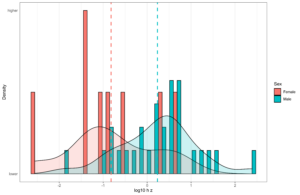Davide Piffer and I have a new study out:
-
Piffer, D., & Kirkegaard, E. O. W. (2024). Evolutionary Trends of Polygenic Scores in European Populations From the Paleolithic to Modern Times. Twin Research and Human Genetics, 1–20. https://doi.org/10.1017/thg.2024.8
This study examines the temporal and geographical evolution of polygenic scores (PGSs) across cognitive measures (Educational Attainment [EA], Intelligence Quotient [IQ]), Socioeconomic Status (SES), and psychiatric conditions (Autism Spectrum Disorder [ASD], schizophrenia [SCZ]) in various populations. Our findings indicate positive directional selection for EA, IQ, and SES traits over the past 12,000 years. Schizophrenia and autism, while similar, showed different temporal patterns, aligning with theories suggesting they are psychological opposites. We observed a decline in PGS for neuroticism and depression, likely due to their genetic correlations and pleiotropic effects on intelligence. Significant PGS shifts from the Upper Paleolithic to the Neolithic periods suggest lifestyle and cognitive demand changes, particularly during the Neolithic Revolution. The study supports a mild hypothesis of Gregory Clark’s model, showing a noticeable rise in genetic propensities for intelligence, academic achievement and professional status across Europe from the Middle Ages to the present. While latitude strongly influenced height, its impact on schizophrenia and autism was smaller and varied. Contrary to the cold winters theory, the study found no significant correlation between latitude and intelligence.
We used a large sample (n = 2625) of European-ish ancient genomes to look at recent selection in humans. With regards to cognition, using educational attainment and intelligence GWAS models, it looks like this:
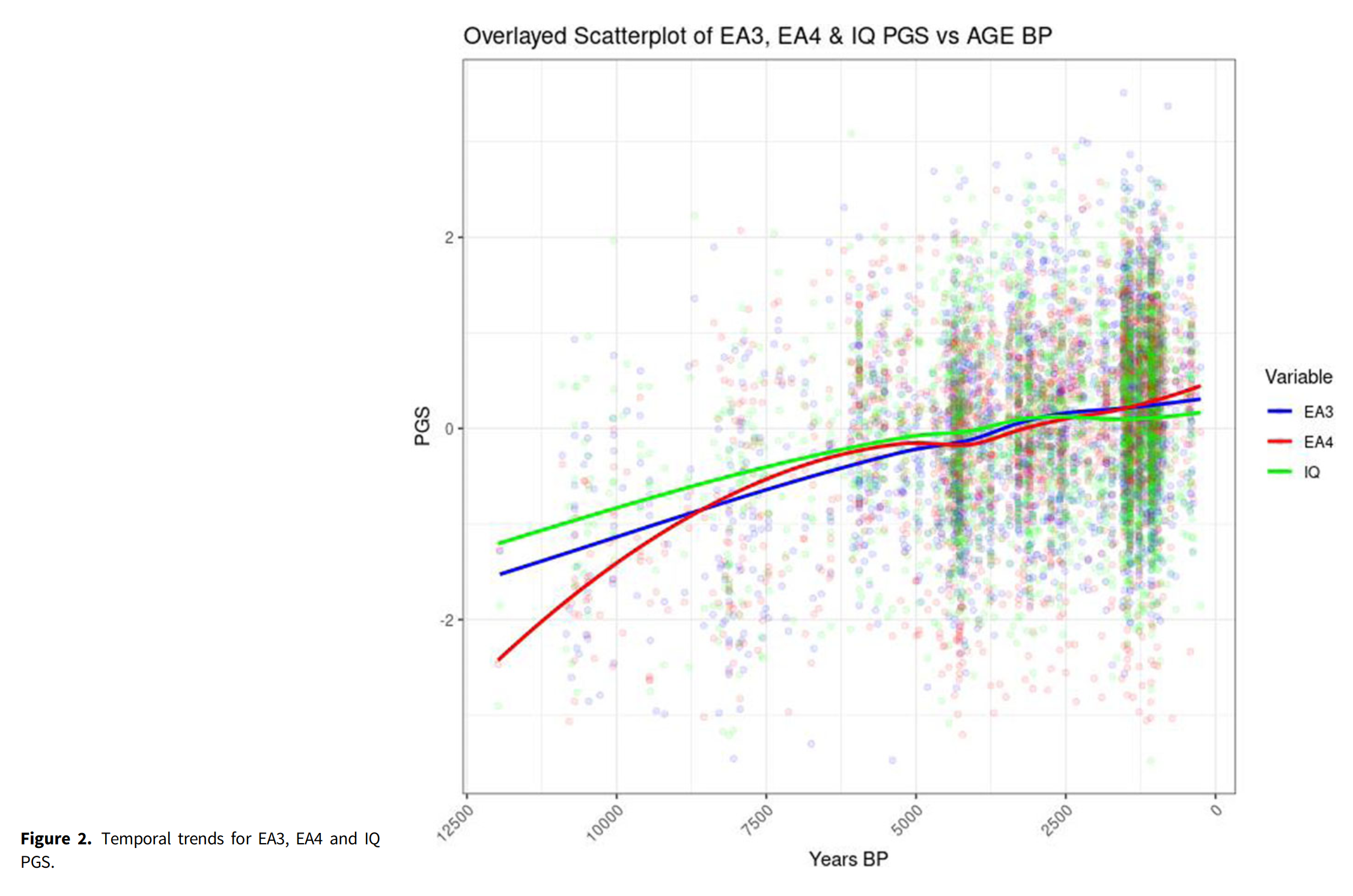
Luckily, the three different polygenic scores (PGSs) were in agreement, making it likely that this trend is mainly intelligence, and not just some other aspect of educational attainment (non-cognitive traits). We can also look at these changes at the level of historical periods:

The transition from the old stone age (paleolithic) to the new (neolithic) shows a big jump, followed by a more steady increase.
Autism (autism spectrum disorder, ASD), showed a possibly related positive trend:
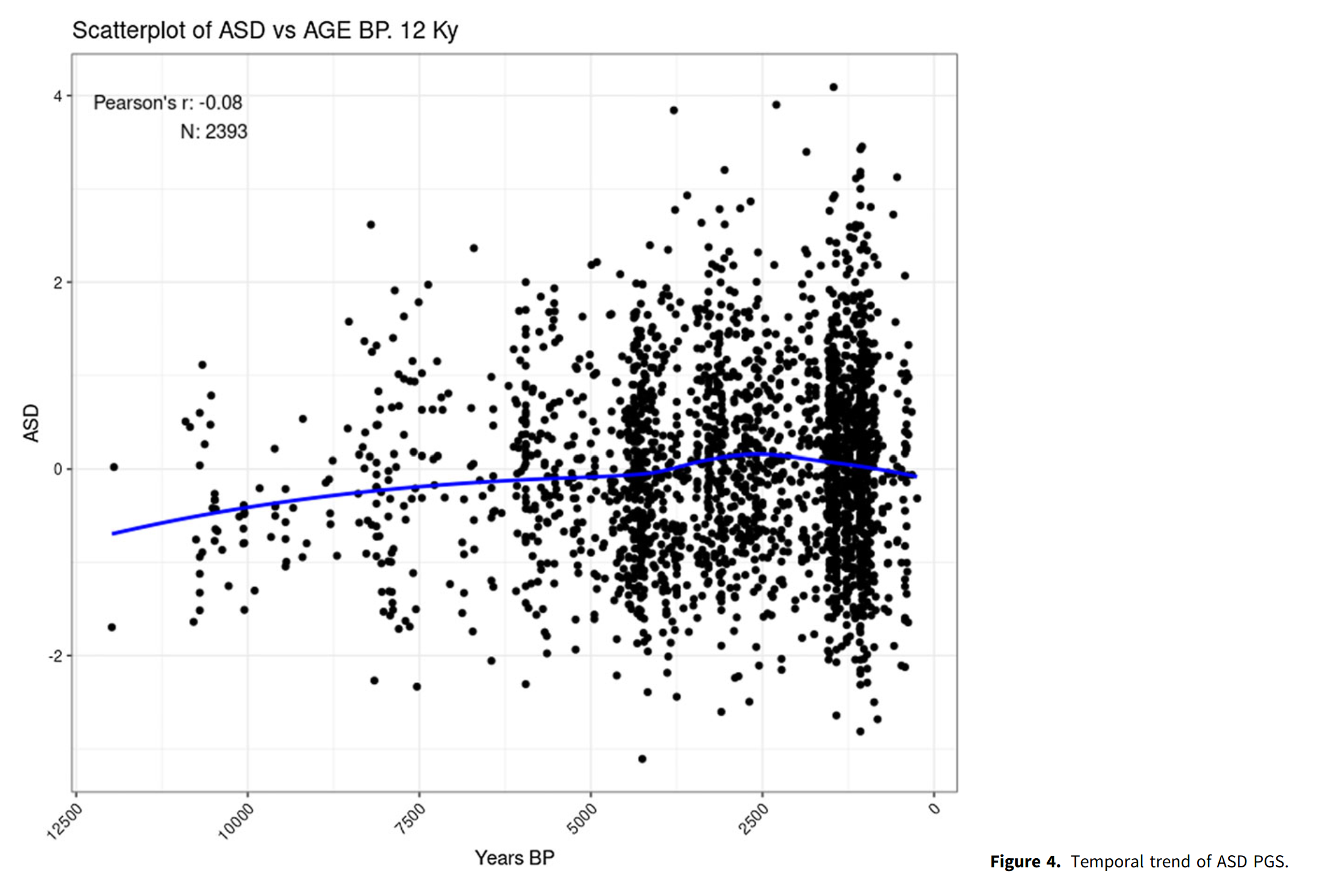
As we noted, it could be due to its genetic correlation with intelligence:
The phenotypic level shows a negative correlation between cognitive ability and risk for schizophrenia (Keefe, 2008). Cognitive impairments in schizophrenia patients are distinct from their clinical condition (Bilder et al., 2000; Glahn et al., 2007; Goldberg et al., 2009; Gottesman & Gould, 2003; Lencz et al., 2006). These impairments start in early childhood and persist before illness onset, affecting educational achievement (Reichenberg et al., 2010; Snitz et al., 2006). The molecular genetic level also shows an inverse relationship with cognitive ability (Comes et al., 2019; Hill et al., 2016; Lam et al., 2017; Lencz et al., 2014; Smeland et al., 2017).
We hypothesize an opposite temporal trend to cognitive ability, with PGSs decreasing over time, supported by recent studies (González-Pe˜nas et al., 2023). A similar trend is hypothesized for depression, negatively correlated to complex cognition (Cullen et al., 2015; Lim et al., 2013; Snyder, 2013). Autism, especially high-functioning autism or Asperger’s syndrome, is predicted to follow a similar trend as IQ and EA (Grove et al., 2019). Urban societies may have influenced the selection for autism-related traits while presenting challenges for individuals with schizophrenia (Lederbogen et al., 2011; Marcelis et al., 1999; van Os et al., 2010). Modern societies may select against traits associated with conditions like schizophrenia, contrasting with the value placed on such traits in traditional societies.
In other words, the various polygenic scores overlap a bit (pleiotropy), making it difficult to see what evolution is acting upon as such, but we can still see the directions things are moving in. From evolution’s perspective, it doesn’t matter if you are selecting for intelligence, and getting a little autism on the side, or whether you are selecting for both and getting the same result. Using the relative rates of selection to examine the driving traits is difficult because the different polygenic scores don’t have the same level of accuracy (r²). This was seen for EA/IQ, where EA PGSs are more accurate and show a stronger relationship to age than the IQ PGS, but perhaps just because the IQ PGS is less accurate.
As would be expected based on the genetic correlations above, schizophrenia showed the opposite trend of autism:
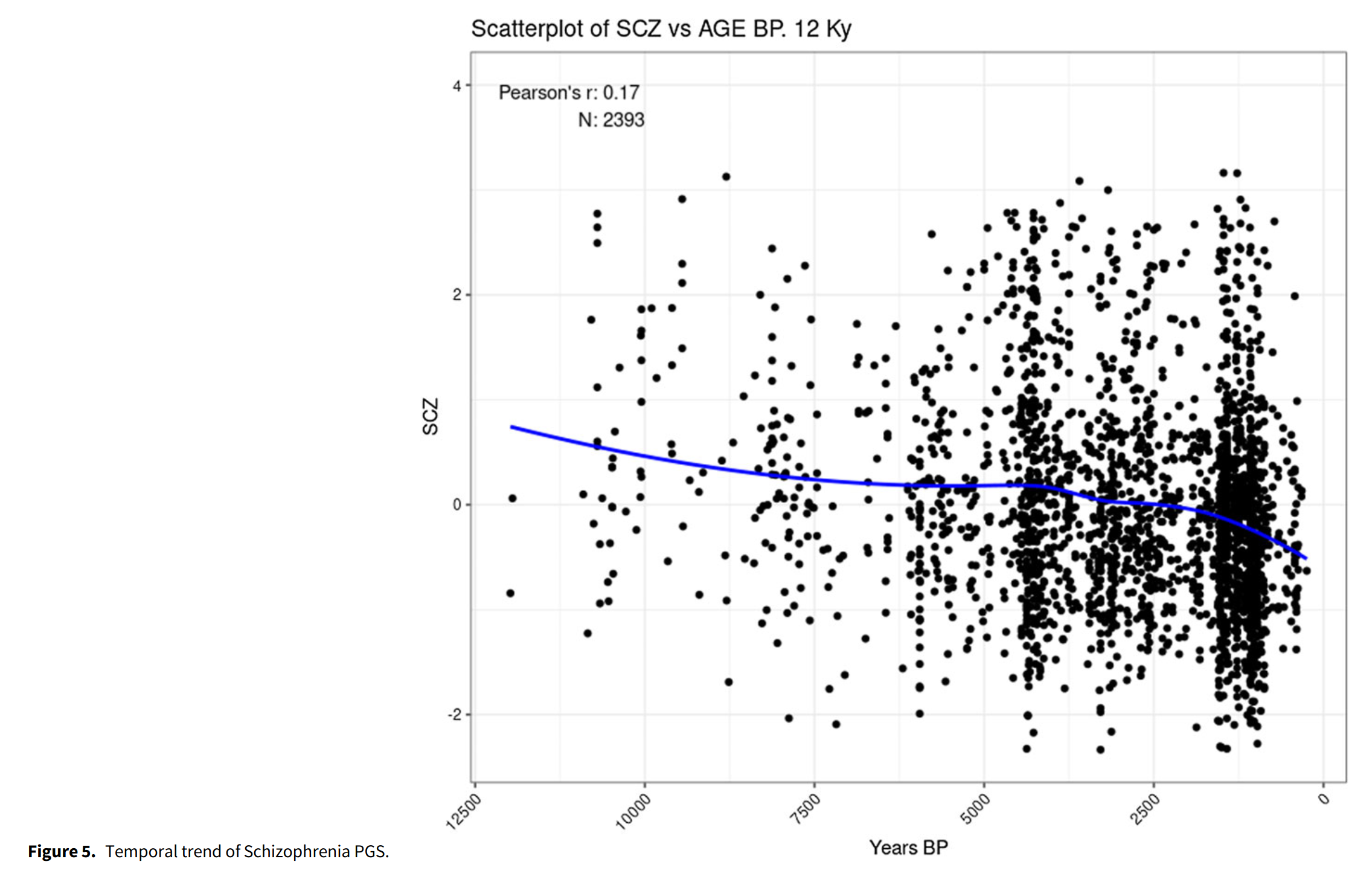
Humans have become less religious over time (at least in the very recent history), and less crudely superstitious (in the last few hundreds of years), and this fits the decline in schizophrenia, which is related to over-perceiving intents behind non-agency behaviors or natural variation (e.g., floods/droughts are attributed to river gods). But again, it may just reflect the selection in favor of higher intelligence due to their negative genetic correlation.
Depression, another psychiatric trait, shows about the same pattern as schizophrenia:
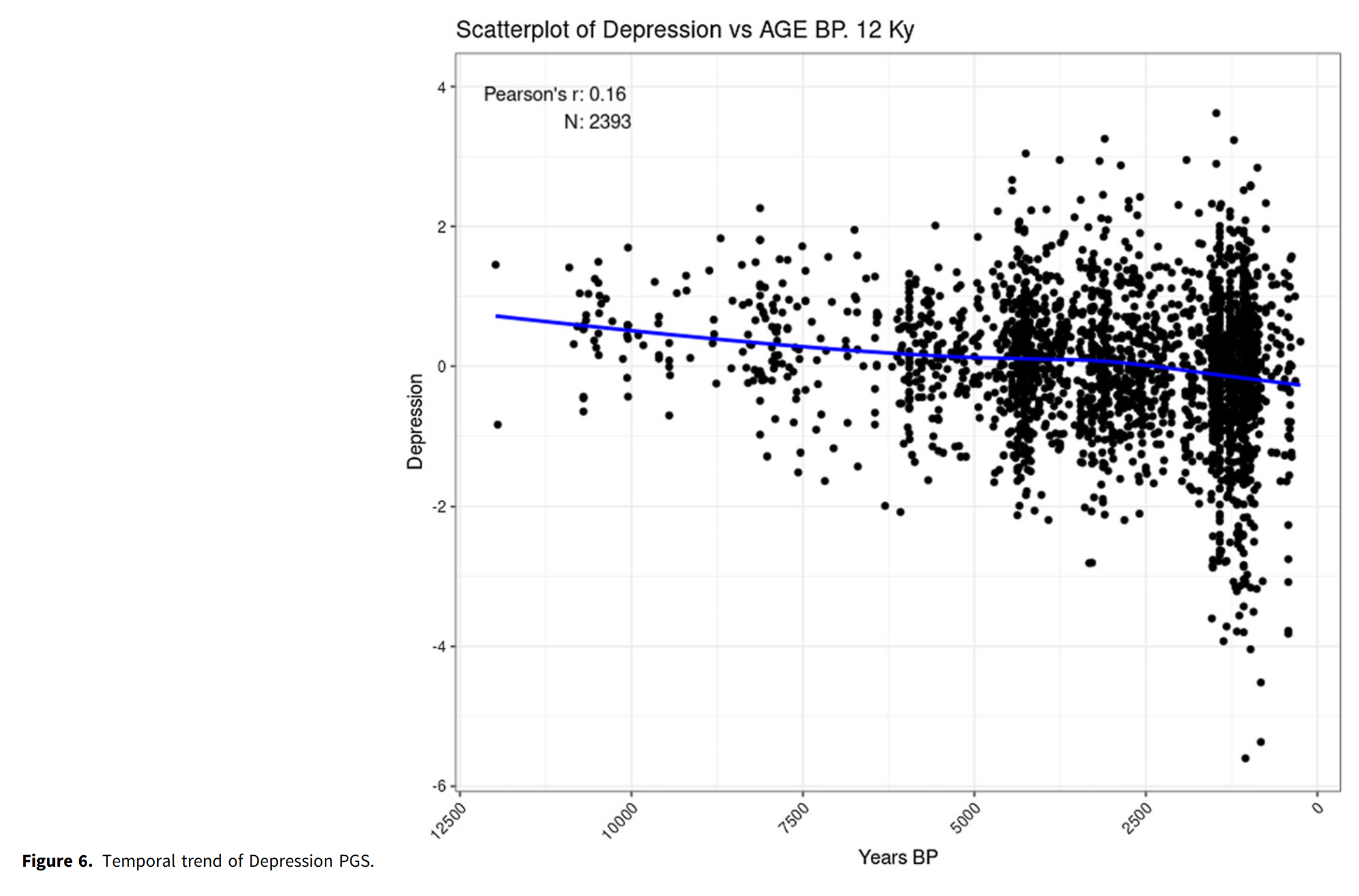
Which is also true for neuroticism:

In general, if selection was mainly against mental illness in itself, one would expect all the trends for mental traits to be decreasing, but instead we find that autism shows an increase. All of these align with their relationships to intelligence. This suggests much of this general pattern is driven by selection for intelligence itself. It would be interesting to look at a few more cases like this. Anorexia has a notably large positive relationship to intelligence, and its historical trend would be interesting.
With regards to Gregory Clark’s A Farewell to Alms, there is some evidence in its favor. Here we looked at only genomes from England:
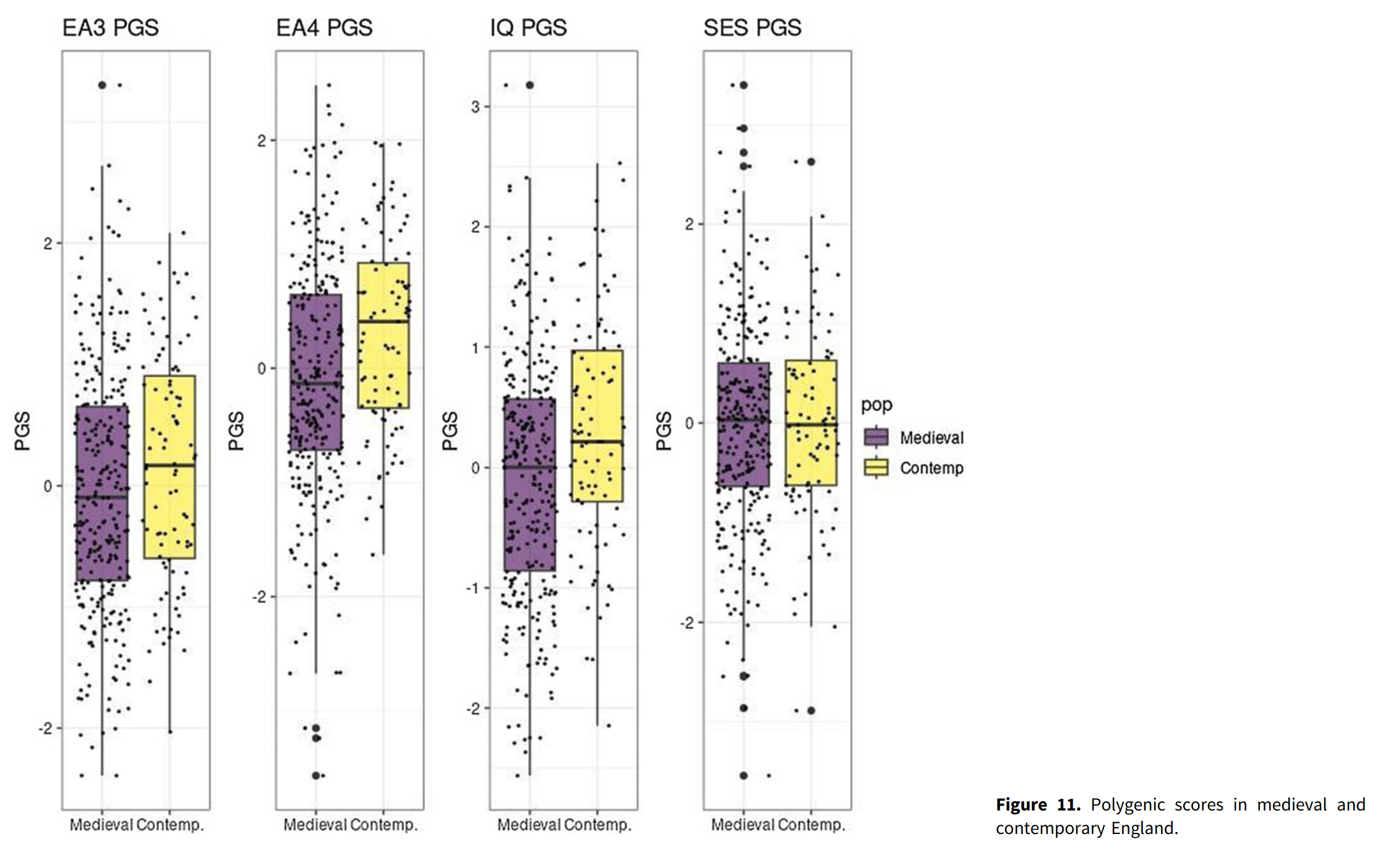
However, selection didn’t seem to be stronger in England than in other places. As such, there doesn’t seem to be a reason that this would support England’s pivotal role as the initiator of the industrial revolution and modern society. Perhaps instead, England was just the first (sub-)civilization that managed to combine the right cultural approach with the higher intelligence that had been evolving the last many thousands of years. In other words, it could have happened in the Netherlands, Germany, or Sweden, but England got there first.
With regards to height, there is a non-monotonic trends:

The higher scores in the very old samples suggest that hunter-gatherers were taller, genetically speaking, but were replaced by shorter farmers, who later merged with the Yamnaya (also tall) and then re-evolved higher stature:
Notably, a decline in height PGS was observed from the Paleolithic to the Neolithic periods, implying that the post- agricultural revolution reduction in body size could be attributed not only to dietary limitations and heightened prevalence of diseases (Mummert et al., 2011), but also to genetic factors. We found a positive impact of EHG ancestry on the height PGS (β = 0.93). This result replicates the finding that differences in height between contemporary northern and southern Europeans are due to different amounts of Steppe ancestry (which is used as a proxy for EHG) rather than selection (Irving-Pease et al., 2024).
Importantly, there are also ancestry specific effects when using regressions:
This is reflected by the sharp increase in EA3, EA4 and IQ PGSs between the Upper Paleolithic and the Neolithic (Supplementary Figures S1, S2, S3). Hunter-gatherer ancestry (particularly V2 or WHG) was negatively associated with EA3, EA4 and IQ in the regression models (Supplementary Tables S1−S3) even after accounting for Years BP (β = -0.314, -0.4, -0.249), suggesting that the increase in cognitive capacity was not solely driven by the Neolithic revolution but was partly mediated by admixture with the immigrants that accompanied it. Anatolian Neolithic farmers who intermixed with native HGs contributed between approximately 40% and 98% of Neolithic European ancestry (Chintalapati et al., 2022). Near-Eastern ancestry (V4) had a similar negative effect on the three phenotypes (−0.31, −0.88 and −0.313).
In other words, hunter-gatherers were replaced by a smarter population. Evolution doesn’t just happen within a population, but also by population replacements.

The five ADMIXTURE components potentially represent:
V1 —West Asian/Iranian ancestry,
V2 — Western European Hunter-Gatherer (WHG)
V3 — Eastern European Hunter-Gatherer (EHG)
V4 — Near Eastern Ancestry
V5 — Anatolian/European Neolithic farmer.
The English seem to have not gotten genetically taller over time:
Indeed, polygenic height scores achieved their highest levels in medieval Dutch, English and Viking populations (Supplementary Figure S13). In contrast, contemporary British samples exhibited lower polygenic height scores compared to their medieval English counterparts. This observation raises two plausible interpretations: either there has been negative selection against height since the Middle Ages, or the ancestral composition of the medieval sample leaned more towards continental ancestry, resembling the Dutch and Scandinavian populations.
We might speculate that this results from the admixing with the non-Germanics (Celts) over time that were already present in the British Isles, but which were pushed to the rim during the migration period. In other words, England used to be more Germanic than it is now because the Celts have been mixing with them (moving south and east).

It seems Vikings were relatively tall for their period, which aligns with historical comments. Height gives an advantage in hand-to-hand combat, so probably this has some role in explaining the great combat skills of the Vikings in their relatively short reign. Vikings did not seem to be particular bright:
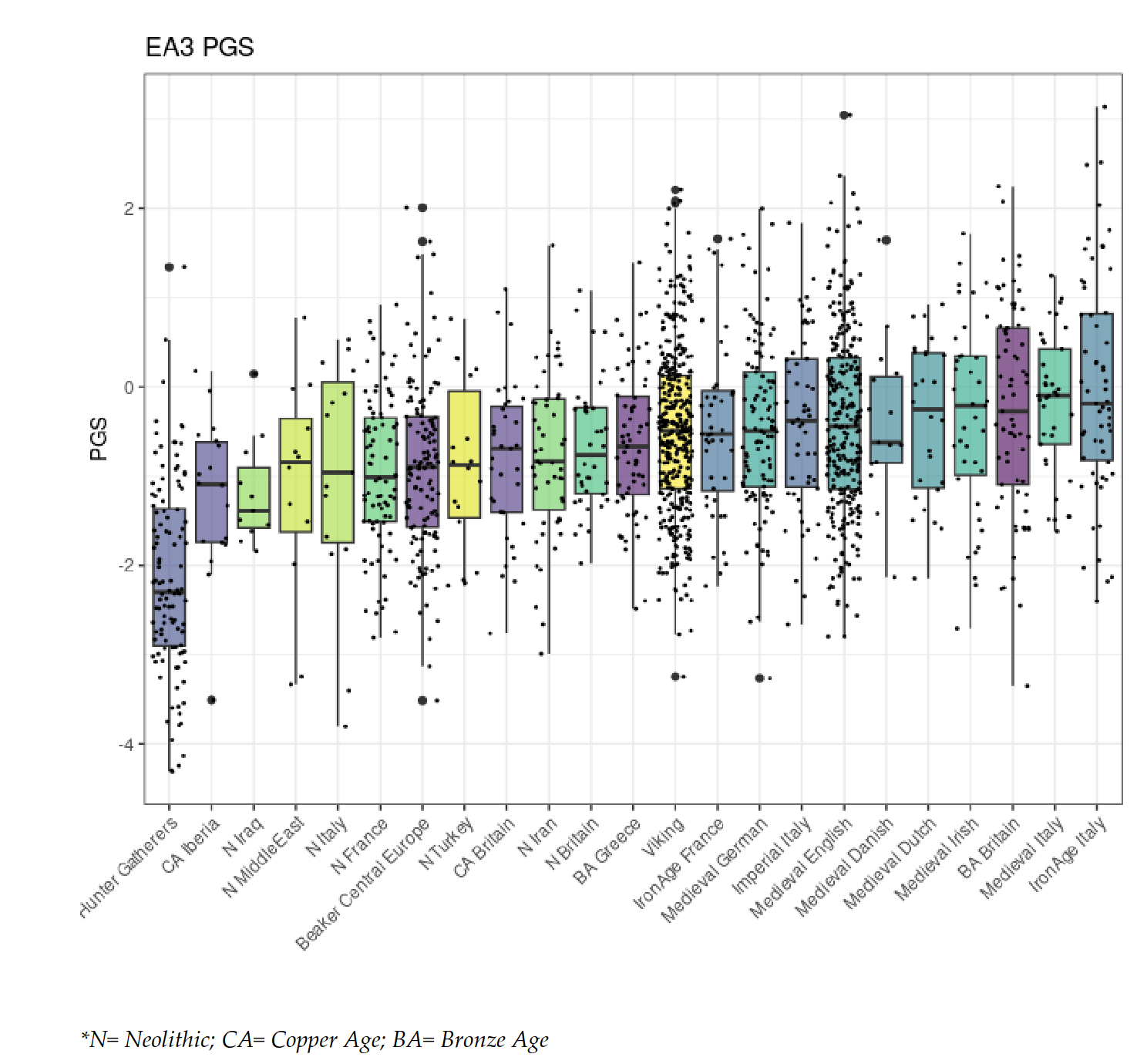
Here we also replicate the finding that Iron Age Italians — early Romans — were quite bright. Notably, this was after adding some more genomes from the Etruscans to the sample.
An important finding, given my own writings, was that concerning cold winters theory:
However, the data do not support the cold winters theory of intelligence (Lynn, 1991, 2006), as the effect of latitude on EA3 and IQ in the regression models (Supplementary Tables S1 and S3) tended to be slightly negative (β = −0.055 and −0.097, p = .022 and p < .001 respectively), contrary to the theory’s prediction. This implies that, at least within the temperate zone from which our samples were derived (30.64 to 69.65°), and within the last 12,000 years, climate did not exert a discernible selective pressure. Indeed, Eastern Hunter Gatherer ancestry, which derived up to 70% of ancestry from Ancient North Eurasians living in the extremely cold climates of Siberia (Posth et al., 2023), was a negative predictor of EA or IQ in the regressions. It is possible that any selective pressure on intelligence from challenging natural environments was offset by the difficulties in forming complex, highly populated societies in ancient times, thereby disabling the gene-culture coevolutionary mechanism that appears to have accompanied humans over the last 12,000 years.
It may be that within this time-frame and limited geographical window, the climate selection is too weak to see among all the other factors that drove evolution. We will have to expand to the global population of ancient genomes to get a more complete picture. Since this would necessarily force cross-race comparisons (for ancient genomes anyway), such results could not easily be published in mainstream journals. An example of politics limiting science. On the other hand, most ancient genomes are from Europe, and there’s only very sparse data for many regions due to poor environment for preserving bones from which DNA can be extracted. This is on top of the locals’ relative lack of interest in finding and preserving them.
The study and its results also have all the usual limitations concerning polygenic scores:
- The genetic prediction models (GWASs) are trained on Europeans, and this results in lower accuracy in non-Europeans, and in general in ancestries that are more distant to the current European admixture of ancient populations. There is the possibility of ancestry related biases from ascertainment biases or other exotic types of non-classical errors. We cannot be sure these aren’t there yet. This issue will be resolved once genetic models are trained on whole genome sequencing data instead of imputed array data, and with more diverse subjects, not just Europeans.
- Burial rites and customs affect whose genomes get preserved. Some cultures practiced cremation (burning) of high status members, thus making their genomes unavailable for analysis (and for cloning, sadly!). In the same way, many genomes come from cemeteries whose sampling may not be representative. There’s not much we can do about these biases except to collect more data and try to see how important they are.
- If there’s any true gene-environment interactions of importance, they are ignored here, as the genetic models only include additive genetic effects. In the same vein, we cannot be sure that phenotypes move in the same directions as the genetic scores do because environmental factors may be opposite of the genetic ones. We know this is the case in recent history (secular paradoxes), so it may be the case in the past as well.
Summary
- Analysis of 2625 ancient European genomes show extensive signals of selection for and against different traits. Positive selection for educational attainment, intelligence, autism, height, and selection against schizophrenia, depression, and neuroticism.
- It’s hard to tell which traits evolution is actually acting on, but this pattern of results align with the genetic correlations of intelligence: all traits with positive genetic correlations with intelligence are under positive selection, and those with negative genetic correlations are under negative selection. This suggests selection for intelligence is driving much of this constellation of results.
- There are some non-continuous changes in some genetic scores. These relate to population replacements. The farmers seem to be smarter than the hunter-gatherers, and their replacement increased intelligence faster than within population would have done. Group selection in action.
- Comparison of English genomes over time suggest Gregory Clark’s model is right, but this selection isn’t any stronger than elsewhere, which doesn’t align with England’s unique role in kicking off the industrial revolution.
